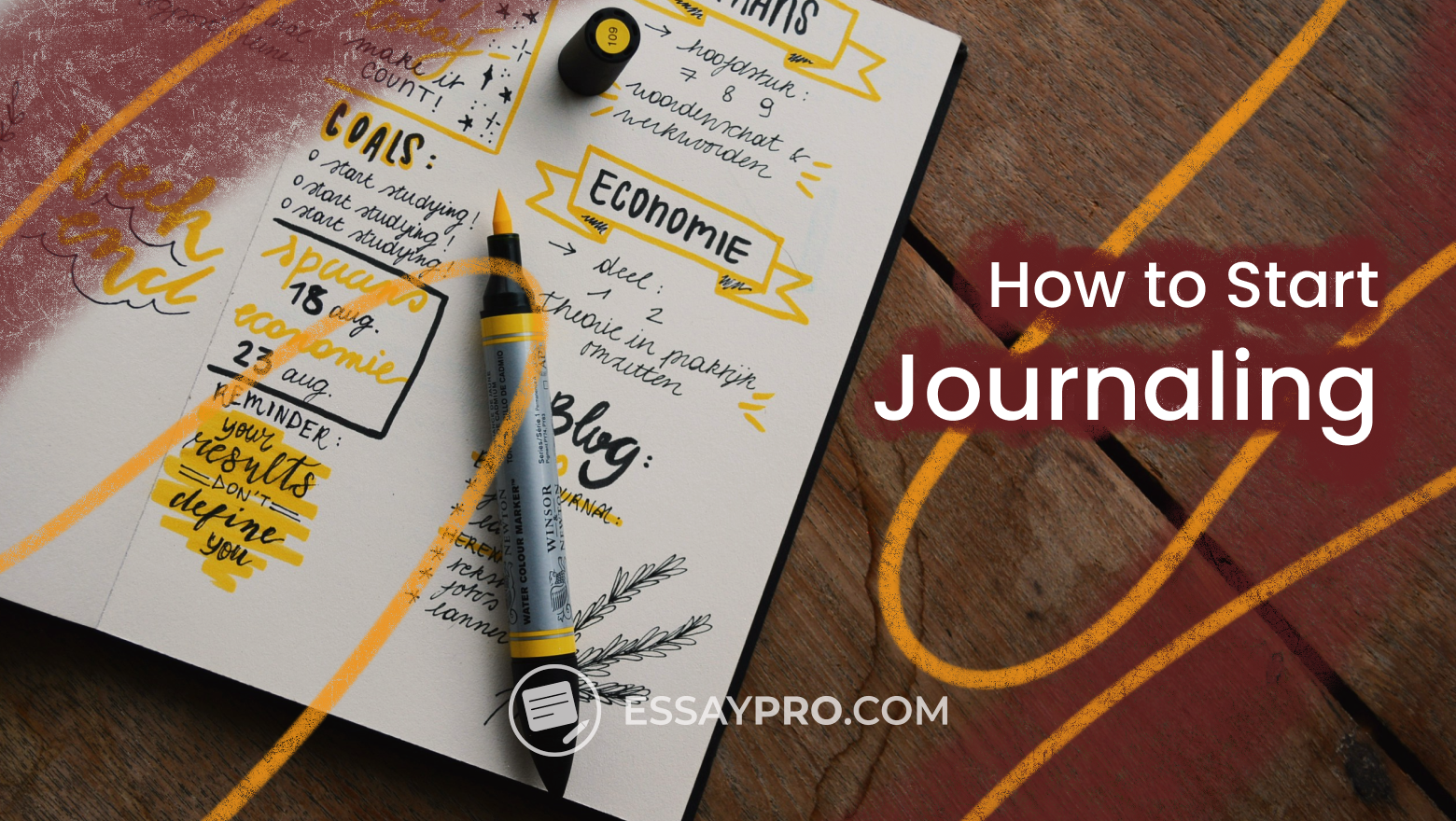More than 70% of teachers feel hopeful about what AI might bring to their classrooms. That's not a small number, and it clearly signals a shift. Educators are not just hearing about artificial intelligence in the news anymore, rather they are using it. And in many cases, they're also welcoming it.
As a matter of fact, the EssayPro team found that 38% of school teachers have already used AI-based tools in their teaching over the past year. That means more than a third have already crossed the threshold.
This article digs into how teachers are responding to AI by looking at what's changing in their profession right now and what might happen next. If you're a student feeling the pressure of this shift, EssayPro is one place that can help. Our platform can give you the right kind of academic help to keep up with the pace of how learning is evolving.


AI and Education on the Global Stage
AI is making its way into classrooms, for sure. But certainly not on a shared timeline. Some countries are building entire curricula around using AI in education. Others are still asking basic questions about when, where, and if it belongs at all. An entire patchwork of different policies and experimentation is emerging.
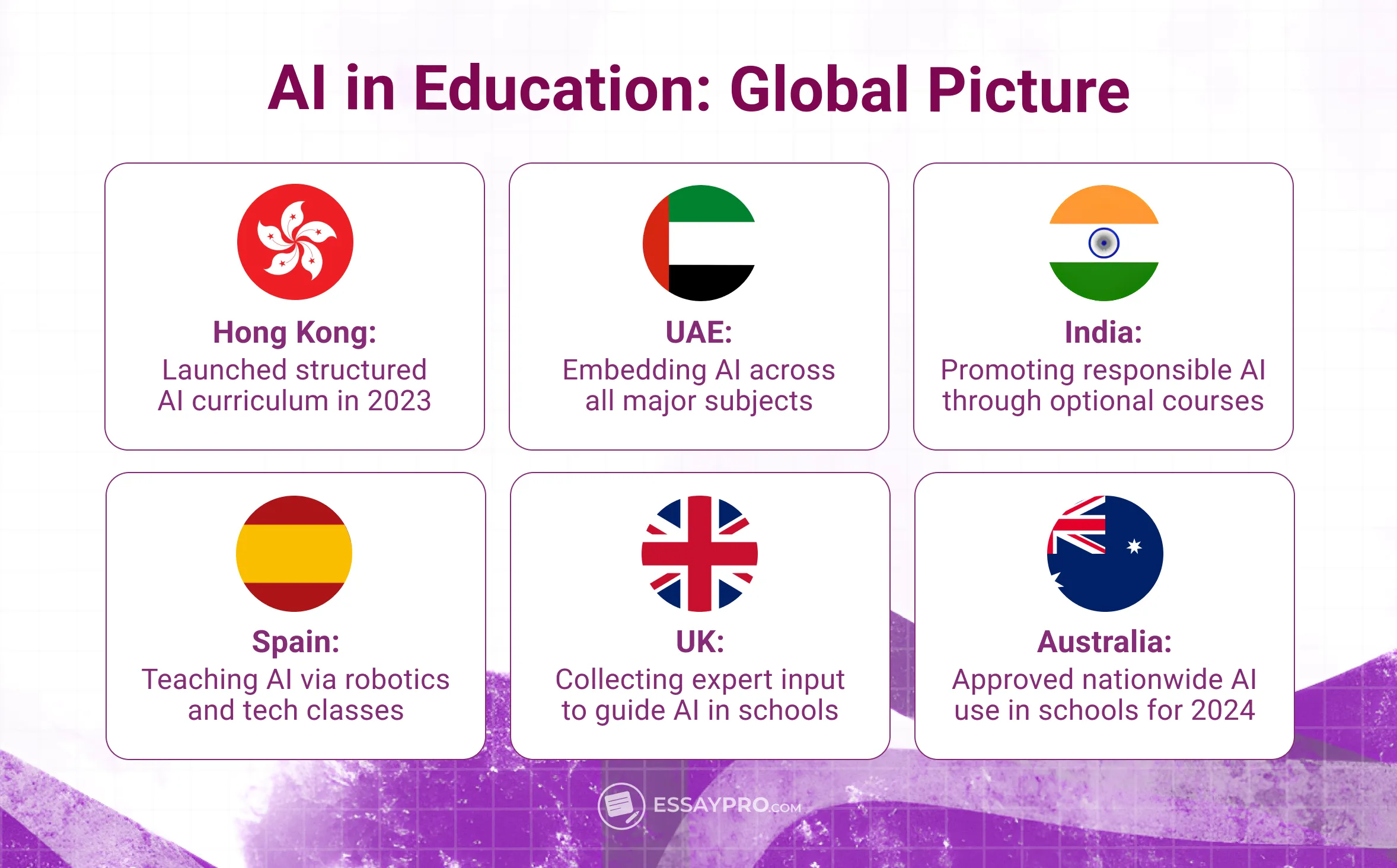
Teachers around the world are curious, cautiously optimistic, and in many cases, simply under pressure. AI promises lighter workload but it also brings questions. How do we protect privacy? What happens when AI gets something wrong? Where's the line between helping a student and replacing the work entirely?
Global Attitudes Toward AI in Education
Every country is responding to the rise of AI in education differently. Here's a look:
Conclusion & Forward Look
Here’s a quick recap of the forecasts and strategic options:
- AI in education advancing unevenly; <10% of institutions have formal GenAI guidelines.
- Teacher interest is high but tempered by privacy, bias, and misuse risks.
- Initiatives like Hong Kong’s “AI+Subject” pilot programmes, such as AI for Science Education, demonstrate scalable paths that integrate AI into core teaching.
- To mitigate risks, from privacy to bias, governments and institutions should craft tailored policies, ideally following models like UNESCO’s AI Ethics Recommendations.
How Teachers Are Responding to AI in Classrooms
Some teachers are experimenting with caution, some with curiosity. AI is reshaping how knowledge is delivered, how students engage, and even how progress is measured. The pros and cons of AI in education are not abstract anymore: they're right here and they're worth talking about.
As we mentioned in the beginning, over 70% of teachers feel optimistic about AI's role in learning. That level of confidence comes from hands-on experience. Educators are beginning to see that AI can help with the somewhat mundane challenges they face daily: planning lessons, managing time, and supporting students who learn at different speeds. Still, this optimism doesn't erase the friction.
Where AI Is Helping Educators Most
AI and education are no longer two separate concepts. In fact, 38% of school teachers and 36% of English language teachers say they've used AI-based tools in their teaching over the past year. For many, these tools save time on time-consuming tasks such as lesson planning and assessments. Others rely on more adaptive learning platforms that adjust to individual students' paces. And don't think that all AI tools can do is solve problems. If used right, they can prevent them from happening in the first place. The system can highlight students who consistently show a pattern of low performance. This way, teachers can step in before the student slips further.
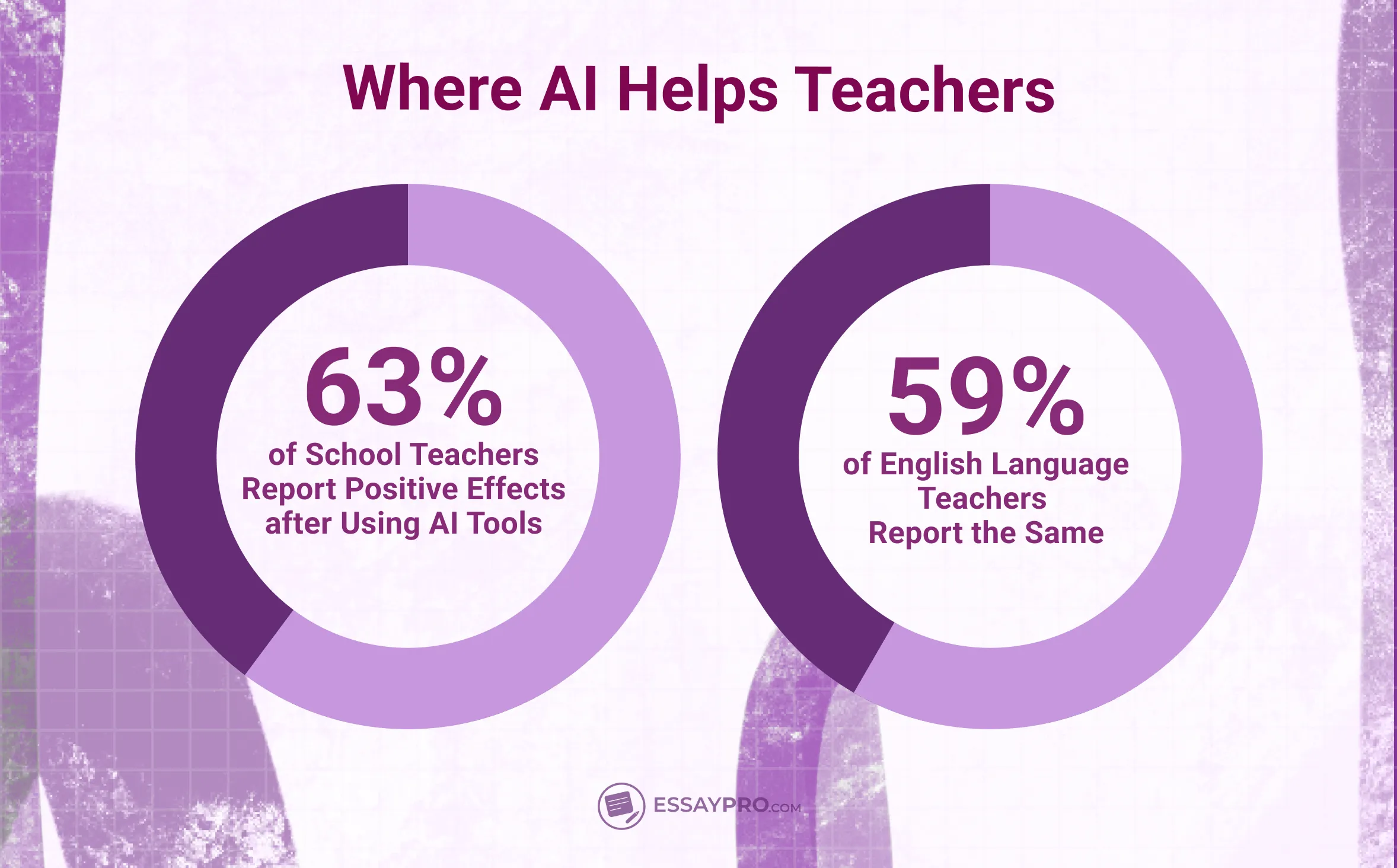
Teachers are seeing changes. EssayPro finds that 63% of school teachers say AI-powered resources have made a real difference in student outcomes. Engagement tends to rise when content feels tailored. Students move more confidently when feedback comes fast. But it's not all progress by far. Many teachers are uneasy. 62% believe AI poses a high risk to the integrity of student work. Another 32% say the risk is moderate. Some suspect students are leaning on AI too heavily - not to learn, but to skip the hard parts. In the UK, nearly half of teachers think their students already use tools like ChatGPT to complete assignments. Several educators mention cheating. Others worry about a drop in critical thinking, or students losing the habit of working through problems on their own.
“If it is used properly, it can only have a positive impact on student learning, creating individualized lessons for all types of learners, and not a ‘one for all’ methodology. I see AI as the ultimate teaching tool for the learner, where the teacher creates materials, questions, or activities for the learner to then use AI to ‘assist’ them in their learning path.”
– English language teacher, Italy
.webp)
What's Still Difficult About Teaching with AI
Teachers still face some obstacles when they try to incorporate AI into their teaching routines. There are two things which are already in short supply in schools - time and training - and adapting to AI demands both. And preparedness is a problem: only 23% of UK teachers felt prepared to work with AI tools in the classroom. This uncertainty slows progress. Teachers can't experiment confidently with AI until they know exactly how to use it.
The demand for support is clear. According to the study conducted by the EssayPro team, 88% of teachers said they would benefit from having relevant insights and research collected in one place. The opinion of English teachers in particular is divided into three parts: one third feels prepared, another third thinks they're unprepared, with the final third being unsure whether they're prepared or not.
.webp)
Without structured guidance, teachers often feel left to experiment on their own. That's risky for student outcomes just as much as it is risky for lesson quality. And another one of the disadvantages of AI for education is AI-generated content: it's becoming more common, so teachers also have to navigate the blurry line between AI writing vs human writing.
Shortly put, the potential of AI is definitely real. But without the right policies and training programs for supporting teachers, that potential remains just out of reach.
Conclusion & Forward Look
Here is a quick look at the most important numbers and predictions:
- By 2026, over 50% of teachers globally are expected to use AI tools weekly for lesson planning and assessment.
- Structured teacher training could cut AI adoption hesitation by up to 40% in early-stage markets.
- Centralized AI teaching resource hubs can reduce lesson prep time by 20–30%, freeing hours for direct student engagement.
- Clear academic integrity policies may curb misuse concerns, currently reported by 62% of educators, by providing transparent guidelines.
- AI-enhanced classrooms piloted in 2025–2026 could produce 10–15% higher student engagement scores.
- Embedding digital literacy and AI ethics in school curricula is forecast to be standard practice in at least 30 countries by 2027.
How AI Is Changing the Way Students Learn
Students are already constantly using AI to get through their daily assignments. At least 80% of them report using it for different academic tasks. Isn't that number huge? And yet, many still feel behind. According to a study by Essaypro, 58% of students say they don't feel like they have enough knowledge to use these tools properly. Nearly as many of them don't feel prepared for an AI-enabled workplace, either. So, while the usage is definitely high, the positive effects of AI on education rarely include confidence.
“I’m afraid that students are going to use [AI] to get out of putting the work in when it comes to doing their homework, and that it’ll add to my workload to check if their assignment might have been completed by using AI technology.”
– English language teacher, Hungary
Check also: Podcast by Sri Krishna on broadening AI participation.
Where AI Makes the Learning Experience Easier
The EssayPro study shows that more than half of students rely on AI for grammar checks, mainly through Grammarly, which is utilized by 84% of all users for proofreading. 42% use it to help write papers, while 39% report that they turn to AI for summarizing long texts. That's the kind of thing that would otherwise eat up an entire evening. 32% of students generate ideas and outlines with AI help, which can often be the hardest part of getting started.
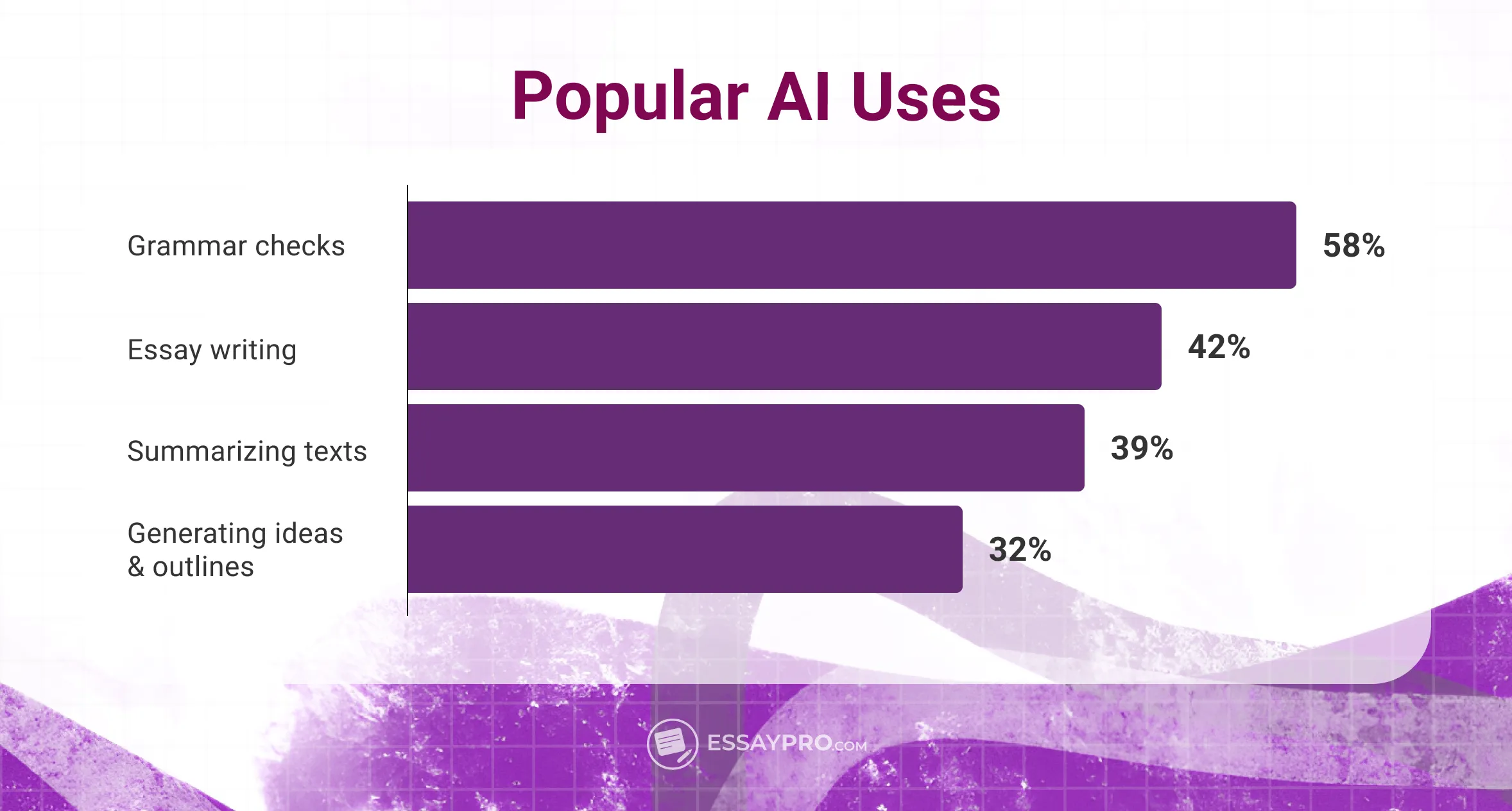
As for the specific tools, ChatGPT is still the go-to. According to one of the EssayPro studies, 41% of users turn to this platform for essay writing, 28% use it for summarization, and only 27% rely on it for generating outlines. Grammarly clearly dominates in the proofreading field, as we already said. Interestingly, 15% also use Grammarly for writing assistance, and 10% even create citations with its help.
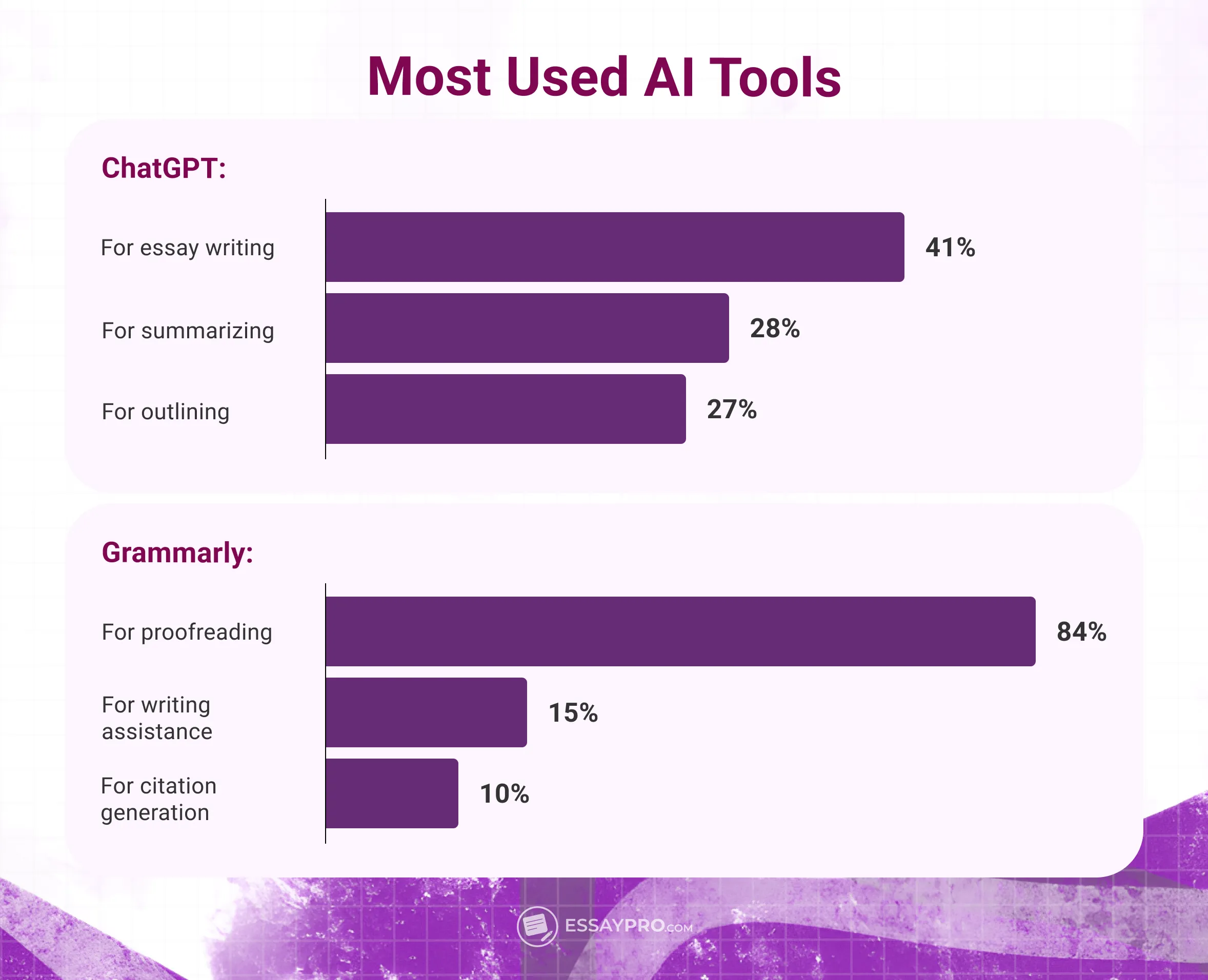
Artificial intelligence in education supports students across different pain points. Instead of feeling stuck, they now have somewhere to start. The convenience is hard to ignore, and when used well, the results often show improvement in both clarity and structure. It doesn't do the thinking, but it makes thinking easier to organize.
Where AI Starts to Get in the Way
Of course, the impact of AI on education isn't just a climb upward. Speed and convenience are great until students realize that they come at the cost of depth. AI doesn't always get things right. More than that, over half of students have caught hallucinating facts, forcing them to double-check everything it generates. That alone can waste the precious time they hoped to save.
Then there's clarity. 33% of students say these tools simply don't understand some subjects deeply enough, causing them to generate vague or, worse, flat-out wrong answers. For some, the struggle begins at the input: 28% of students have trouble writing prompts that lead to useful results. Still, a small group - just 23% - don't report any difficulties regarding AI. It can be powerful, but only if you already know how to ask the right questions. And not everyone does.
So, how are students learning to use these tools? Nearly 75% are relying solely on trial and error. They test prompts, tweak results, try again. Basically, they're teaching themselves, which is often inefficient, but it's what they have. 31% seek help from online forums, while others (27%) scroll through short tutorials. A quarter of students are no strangers to asking for help from classmates and friends.
It's clear that students are expected to understand tools that no one's really explained to them, and that's where the problems begin. AI becomes a shortcut instead of a helper, which weakens the parts of learning that actually matter the most: critical thinking, analysis, and problem solving. If students don't understand a concept but can generate a passable paragraph about it, the gap stays hidden.
Conclusion & Forward Look
Let's review what the forecast’s like:
- By 2026, AI use among students for academic tasks could surpass 90%, but confidence in using these tools effectively may lag without structured training.
- Embedding AI literacy in curricula can reduce the current 58% “lack of knowledge” gap and prepare students for AI-enabled workplaces.
- Schools introducing guided prompt-writing workshops could cut trial-and-error reliance (now at 75%) and improve output quality.
- Fact-checking modules and source-verification tools can address the 50%+ rate of students encountering AI “hallucinations.”
- Adaptive AI learning platforms are projected to boost clarity, structure, and student engagement by up to 15% when paired with teacher oversight.
- Without targeted policy and skill-building, AI risks deepening the gap in critical thinking and problem-solving skills, making balanced integration essential.
Where AI Might Take Us Next in Education
The future of AI in education holds real promise and real pressure. As long as it's done right, AI could make learning a lot more accessible in more ways than ever before. First and foremost, it can make personalized learning much more than a buzzword we keep hearing. We might soon be able to actually tailor lessons to each student's pace. AI could also level the playing field for those with learning difficulties and language barriers, making resources more accessible. It could even allow teachers to spend less time grading and more time connecting with students.
But the risks are already visible. The more AI is used in classrooms, the more questions surface about the reliability of the information it provides. Fabricated facts and oversimplified ideas make it harder for us to trust AI tools as true companions. Then there's the ethical side, of course: academic integrity takes a dip just as AI becomes more popular. At some point, the line between assistance and cheating starts to blur. That’s why more and more teachers are using an AI detector for essays.
What’s also interesting in EssayPro research results is that access remains one of the biggest barriers. Right now, 37% of the world's population has no access to the internet. In underdeveloped regions, where even basic connectivity is limited, AI tools could actually widen the digital divide rather than close it.
And then there's something less technical but just as important: human connection. If education becomes too automated, there's a risk that face-to-face conversation and mentorship could begin to fade. The future isn't just about what technology can do. It's about what we choose to let it do, and where we decide human presence still matters most.
Persistent Problems in Education and How AI Might Fix Them
Some challenges in education seem to dig in and stay, no matter how far technology moves forward. But the intersection of education and AI gives us a chance to build something more flexible than ever before.
Problem: Personalized Learning Still Feels Like a Luxury
Classrooms weren't built for customization. Some students fall behind because the pace is too fast. Others disengage because it's too slow. The time and resources needed to bridge this gap only stretch so far. As a result, a lot of students get stuck somewhere in the middle of frustration and uneven progress.
AI offers a way through. Tools that track how students learn can now recommend materials tailored to their level. Lesson difficulty can change mid-stream, depending on how a student performs. Real-time feedback is already a built-in feature. Still, AI helps, but it doesn't replace the need for human guidance when the work feels too heavy.
Problem: Teachers Are Overwhelmed and Undersupported
The answer will be the same from any educator when you ask them what they need more of: time. Between technical tasks and emotional support, most teachers have to do the jobs of five people at the same time. And professional development is often just an afterthought (if it happens at all).
This is exactly where AI can give us something useful. It can take over and automate the small, mundane tasks and even suggest ways to adapt lessons according to students' needs. It definitely can't solve burnout altogether, but it might take away some of the tasks that burn us out the fastest.
Problem: Educational Content Is Expensive and Slow to Update
Up-to-date materials are not handed out. They are also costly. Textbooks age fast and interactive tools take months to build. The curriculum might need another update by the time something new is developed. It's no surprise some schools can't keep up, which is why students end up stuck with content that's not aligned with the real world.
AI speeds up this pace. It can generate quizzes and build interactive lessons without a production team. What might have taken a semester to roll out can now be done in a matter of days. Students can get personalized content in a language they actually understand.
Wrapping Up
AI is part of the workflow, and there's no point in denying it. In some ways, it's definitely a breakthrough: students get quicker feedback, teachers save precious hours, and lessons can be bent to individual needs.
But something else gets complicated with every new solution - students worry about using AI the right way. Some feel more efficient, sure, but also less connected to the work. Teachers are also handed the tools without proper training. Concerns about misinformation and tech access gaps? Still very real.
We're moving fast, maybe faster than we can absorb. The question now isn't whether AI belongs in education but rather how much control we keep as it grows.
If you're a student looking for real human help amidst different AI tools, EssayPro is where you can slow down. Our professional writers can help you with the structure and clarity of your work without any guesswork.
FAQ
What are the Benefits of AI in Education?
AI helps personalize learning because it allows students to move at their own pace and receive instant feedback. It automates time-consuming tasks for teachers so they can focus more on connecting with learners. AI can also improve accessibility by tailoring lessons to different learning needs, making education more inclusive and efficient.
How is AI Changing the World of Education?
AI is changing how we learn in more ways than one. Students don't always wait for a teacher's reply - they ask an AI instead. Some classrooms are experimenting with adaptive platforms that shift in real time. Others are using AI to translate and organize. Education is becoming more flexible, more personalized, and, for better or worse, less human in the process.
How is AI a Problem in Education?
AI doesn't always get the facts right, even though it sounds like it does. There's also the issue of effort as some use AI not to learn, but to skip the hard parts. And let's not forget that some students don't have the internet at all, meaning that the gap is not shrinking fast enough.

Ana Ratishvili
Ana is a professional literary writer with a Master’s Degree in English literature. Through critical analysis and an understanding of storytelling techniques, she can craft insightful guides on how to write literary analysis essays and their structures so students can improve their writing skills.
- Oxford University Press. (2023, October 18). AI in education: where we are and what happens next. Oxford University Press. https://corp.oup.com/feature/ai-in-education-where-we-are-and-what-happens-next/
- Ahmet Göçen, & Fatih Aydemir. (2020, December). Artificial Intelligence in Education and Schools. ResearchGate; Walter de Gruyter. https://www.researchgate.net/publication/352044231_Artificial_Intelligence_in_Education_and_Schools
- Zhang, K., & Aslan, A. B. (2021). AI technologies for education: Recent research & future directions. Computers and Education: Artificial Intelligence, 2(100025), 100025. https://doi.org/10.1016/j.caeai.2021.100025
- UNESCO. (2023, June 1). UNESCO survey: Less than 10% of Schools and Universities Have Formal Guidance on AI. Unesco.org. https://www.unesco.org/en/articles/unesco-survey-less-10-schools-and-universities-have-formal-guidance-ai
- AN INTERNATIONAL PERSPECTIVE ON DIGITAL LITERACY Results from ICILS 2023. (n.d.). https://www.iea.nl/sites/default/files/2024-11/ICILS_2023_International_Report_0.pdf
- Johri, M., & Yadav, R. (n.d.). International Journal of Teaching, Learning and Education (IJTLE) The Impact of AI on Student Engagement and Learning Outcomes. Retrieved August 14, 2025, from https://media.neliti.com/media/publications/617037-the-impact-of-ai-on-student-engagement-a-d19266fc.pdf
- Guidelines on Developing Effective Academic Integrity Policies FAITH Project A Comprehensive Guide for Higher Education Institutions. (n.d.). https://www.academicintegrity.eu/wp/wp-content/uploads/2025/02/Guidelines-on-Developing-Effective-Academic-Integrity-Policies.pdf
- OECD. (2024). THE POTENTIAL IMPACT OF ARTIFICIAL INTELLIGENCE ON EQUITY AND INCLUSION IN EDUCATION. https://www.oecd.org/content/dam/oecd/en/publications/reports/2024/08/the-potential-impact-of-artificial-intelligence-on-equity-and-inclusion-in-education_0d7e9e00/15df715b-en.pdf
- Trust, attitudes and use of artificial intelligence A global study 2025. (n.d.). https://doi.org/10.26188/28822919
- Navigating the future of AI in education and education in AI How governments can forge more effective and equitable learning systems and develop workforces with future-ready skills. (n.d.). https://www.ey.com/content/dam/ey-unified-site/ey-com/en-ae/insights/education/documents/ey-education-and-ai-v6-lr.pdf






